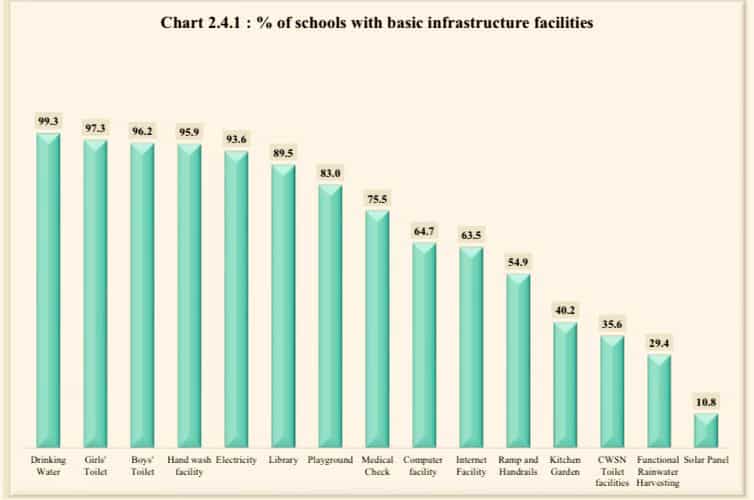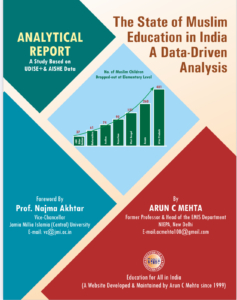Enhancing Competencies of Educational Planners in India
Navigating the Digital Era and AI Integration
Introduction
In the rapidly evolving education landscape, particularly in a diverse and populous country like India, educational planners are pivotal in shaping policies and practices that ensure equitable access to quality schooling. With the advent of the digital era and the integration of artificial intelligence (AI), the competencies required for planners at sub-national (district and block), state, and national levels have undergone significant transformation. This article explores these competencies, focusing on school education, drawing attention to the challenges posed by limited digital infrastructure, persistent structural issues in schools, and the need for data-driven planning under schemes like Samagra Shiksha. As highlighted on educationforallinindia.com, a platform dedicated to advancing universal education through data analysis and policy insights since 1999, the journey toward inclusive education demands planners who are adept at traditional management and proficient in leveraging technology to address disparities.
The National Education Policy (NEP) 2020 marks a watershed moment, emphasizing digital tools and AI to bridge gaps in learning outcomes. However, planners must contend with realities such as uneven access to digital devices in schools and households, alongside longstanding issues like single-teacher schools and multi-grade teaching. This piece reviews the present status, identifies competency gaps, and proposes enhancements, while aligning with ongoing initiatives like the India AI Mission to foster a more resilient educational framework.

Percentage-Distribution-of-Schools-by-Facilities-UDISEPLus-2024-25
Review of Current Status and Competencies
Digital Infrastructure in Schools and Households
India’s digital landscape in education reveals a mixed picture of progress and persistent divides. Recent data from the Annual Status of Education Report (ASER) 2024 indicates that approximately 84% of rural households now own smartphones, reflecting a surge in connectivity driven by initiatives like Digital India. Yet, this household-level access often prioritizes social media over educational use, with 76% of teenagers aged 14-16 engaging in entertainment compared to just 57% utilizing devices for learning purposes. The situation shows improvement in schools but remains concerning: 64.7% have functional computers, and 63.5% are equipped with internet access, as per the Unified District Information System for Education (UDISE+) 2024-25 report. These figures underscore a digital divide, particularly in rural areas, where infrastructure lags behind urban centers, limiting the potential for technology-enhanced teaching.
Planning Practices under Samagra Shiksha
Samagra Shiksha, launched in 2018 as an integrated scheme merging previous programs like Sarva Shiksha Abhiyan and Rashtriya Madhyamik Shiksha Abhiyan, emphasizes decentralized planning at disaggregated levels – districts, blocks, and even schools – to tailor interventions to local needs. This approach relies on evidence-based tools, such as educational indicators for monitoring enrollment, dropout rates, and transitions, disaggregated by gender, caste, and region. Annual plans are developed bottom-up, incorporating data from UDISE+ to address specific challenges. However, implementation faces hurdles in small schools with enrollment below 30, which often operate with single teachers or none, leading to multi-grade teaching scenarios that strain resources and quality. Untrained teachers without professional qualifications further exacerbate these issues, as they struggle with curriculum delivery and administrative duties.
Existing Policies on Digital Devices and AI in Education Planning
The NEP 2020 provides a robust policy foundation, advocating for integrating digital technologies and AI to personalize learning and improve administrative efficiency. It envisions AI-driven tools for assessment, teacher training, and resource allocation, while promoting equitable distribution of devices through schemes like the One Nation One Digital Platform. The policy also calls for school AI curricula to build foundational skills that align with global standards. Complementary efforts under Digital India include expanding broadband access and initiatives like AI for All, which aim to democratize AI education. However, policies acknowledge challenges, such as the need for teacher upskilling to handle AI tools effectively.
Competencies of Educational Planners: Strengths and Limitations
Drawing from the International Institute for Educational Planning (IIEP) in Paris, effective planners require a blend of technical (data analysis, forecasting), relational (stakeholder engagement), and strategic (policy formulation) competencies. In India, national-level planners excel in macro-policy design, such as NEP implementation, while state-level planners focus on resource allocation. Sub-national planners handle grassroots issues but often lack depth in digital competencies, like using AI for predictive analytics in enrolment trends or identifying at-risk students in small schools.
Limitations in handling disaggregated data for multi-grade setups or addressing teacher shortages through AI-optimized scheduling are evident. Planners may overlook the nuances of untrained teachers, where AI could simulate training modules. Improvements can be driven through teachers themselves – by empowering them with AI literacy, they can contribute to localized planning, such as using apps for real-time data reporting, thus bridging the gap between policy and practice.
Steps for Enhancing AI and Digital Integration in Government Schools
To address the unique challenges in government schools located in remote rural areas – such as erratic electricity, poor internet connectivity, and limited resources – targeted steps can significantly improve the use of AI and digital devices in education planning. These recommendations build on frameworks like Samagra Shiksha and NEP 2020, emphasizing scalability, affordability, and community involvement.
- Infrastructure Augmentation with Sustainable Solutions: Prioritize the deployment of solar-powered digital devices and offline-capable AI tools in remote schools. For instance, distribute low-cost tablets pre-loaded with AI-based educational software that functions without internet, enabling multi-grade teaching through adaptive learning modules. Partnerships with organizations like the Rural Electrification Corporation could ensure reliable power backups, while planners at sub-national levels use GIS mapping to identify and prioritize the most isolated areas for initial rollouts.
- Teacher Capacity Building Programs: Implement mandatory AI literacy workshops for teachers, particularly those in single-teacher or small-enrollment schools. These programs, conducted via mobile vans or community centers in remote areas, could teach the use of simple AI apps for lesson planning, student assessment, and data entry into UDISE+. By involving teachers in planning processes, such as co-creating AI-driven schedules for multi-grade classes, planners can gather ground-level insights to refine disaggregated plans under Samagra Shiksha.
- Community-Driven Data Collection and Monitoring: Encourage local communities, including parents and village education committees, to participate in digital data gathering using basic smartphones. AI-powered mobile apps could analyse locally collected data on enrollment and attendance, even offline, syncing when connectivity is available. This step addresses issues in schools without teachers by enabling remote monitoring and alerting planners to deploy temporary resources, fostering a bottom-up approach to planning.
- Pilot Projects and Iterative Scaling: Launch small-scale pilots in selected remote districts, integrating AI for predictive analytics on dropout risks in multi-grade setups. Use feedback loops involving untrained teachers to refine tools, ensuring they are user-friendly and culturally relevant. With funding from the India AI Mission, state-level planners can then scale successful models nationally while tracking progress through real-time dashboards.
- Public-Private Partnerships for Resource Optimization: Collaborate with tech firms and NGOs to provide affordable AI solutions tailored for rural contexts, such as voice-assisted tools in local languages for teachers without professional qualifications; this could include AI chatbots for administrative support, reducing the burden on single teachers and allowing planners to focus on strategic interventions like resource reallocation in low-enrollment schools.
- Policy Advocacy for Equitable Access: Advocate for amendments in existing policies to mandate minimum digital standards in remote government schools, including subsidies for devices and AI training. Planners should leverage IIEP guidelines to integrate ethical AI use, ensuring data privacy in vulnerable areas, and conduct regular audits to measure the impact on learning outcomes.
When integrated into planning cycles, these steps can transform competencies by making AI and digital tools more accessible and effective in challenging environments. Furthermore, AI can significantly lower the administrative burden on schools and MIS coordinators at the block, district, and state levels, given the proliferation of digital online portals such as UDISE+, SDMS, PEN, and AAPAR. AI-driven automation could streamline data entry, cross-verification, and reporting across these platforms, reducing manual efforts and errors while enabling real-time insights for better decision-making.
Concluding Observations
The competencies of educational planners in India must evolve to embrace the digital era and AI, particularly amid challenges like inadequate device access and structural school issues. While policies like NEP 2020 and Samagra Shiksha provide a strong framework, gaps in digital infrastructure and planner skills hinder progress. Enhancing competencies through targeted training, especially involving teachers in AI-driven processes and the recommended steps for remote rural areas, could foster more inclusive planning. As educationforallinindia.com emphasizes, data-driven insights are key to achieving universal education by 2030.
How the Proposed AI Mission Will Be Helpful
The India AI Mission, approved in 2024, aims to build a comprehensive AI ecosystem, including the FutureSkills pillar, to expand AI courses at all educational levels. For planners, this mission offers tools for advanced data analytics, enabling better forecasting in disaggregated planning under Samagra Shiksha. AI can simulate scenarios for small schools, optimizing teacher deployment and addressing multi-grade challenges through personalized learning algorithms. By training planners and teachers in AI competencies, the mission will bridge digital divides, enhance policy implementation, and ultimately improve outcomes in underserved areas, particularly when combined with the recommended steps for rural integration. Additionally, AI integration under the mission can alleviate the workload associated with managing multiple portals like UDISE+, SDMS, PEN, and AAPAR, allowing MIS coordinators to focus on strategic oversight rather than routine data handling.
Suggested Readings
- Annual Status of Education Report (ASER) 2024. ASER Centre.
- Unified District Information System for Education (UDISE+) 2024-25. Ministry of Education, Government of India.
- National Education Policy 2020. Ministry of Education, Government of India.
- IIEP Competency Framework for Educational Planning and Management. International Institute for Educational Planning (IIEP), UNESCO, Paris.
- India AI Mission Framework. NITI Aayog, Government of India.
- Mehta, A. C. (Various articles). Education for All in India. Available at: educationforallinindia.com.


